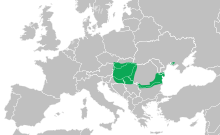Danube crested newt
| Danube crested newt | |
|---|---|
 |
|
| Scientific classification | |
| Kingdom: | Animalia |
| Phylum: | Chordata |
| Class: | Amphibia |
| Order: | Caudata |
| Family: | Salamandridae |
| Subfamily: | Pleurodelinae |
| Genus: | Triturus |
| Species: | T. dobrogicus |
| Binomial name | |
|
Triturus dobrogicus (Kiritzescu, 1903) |
|
 |
|
| Synonyms | |
|
|
|
|
The Danube crested newt or Danube newt (Triturus dobrogicus) is a species of newt found in central and eastern Europe, along the basin of the Danube river and some of its tributaries and in the Dnieper delta. It has a smaller and more slender body than the other crested newts in genus Triturus but like these, males develop a conspicuous jagged seam on back and tail during breeding season.
For half of the year or longer, adults live in slow-flowing river margins, lakes, or ponds, where reproduction takes place. Males perform a courtship display, and females lay around 200 eggs individually onto leaves of aquatic plants. Larvae develop two to four months in the water before reaching metamorphosis. For the remainder of the year, the newts live in shady land habitats, usually forests. Although not yet considered threatened, Danube crested newt populations have declined significantly, the reason being mainly habitat loss. The species is protected by law in the European Union.
The Danube crested newt was described as a variety of the northern crested newt (Triturus cristatus) by C. Kiritzescu in 1903. Later, it was considered a subspecies until genetic analysis supported its recognition as a separate species in the crested newt species complex. The northern crested newt is its likely sister species according to a molecular phylogenetic study based on ; analysis of nuclear DNA gives however some conflicting results regarding this sister relationship.
Separated populations from the Danube Delta and the Pannonian Basin (see Distribution and habitats) were described as two subspecies, T. dobrogicus dobrogicus and T. dobrogicus macrosoma, in 2000. Later genetic study, however, did not support the distinction of these two forms.
...
Wikipedia

